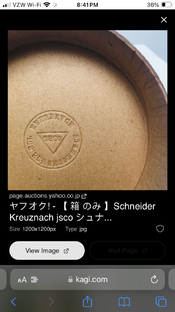aconbere
Subscriber
Hi all,
This lens came with a packard shutter I bought this week. It’s a barrel lens with few markings. Just the ISCO makers mark that identifies it as an early Schneider and the fstops.
It is roughly 300mm with a minimum aperture of 6.8 and maximum of 64.
I believe it is 6 elements in two groups with both the front and back having one cemented and one air gapped element (two large reflections and one small one).
I believe the most likely candidate is that this is a 300mm/6.8 Symmar but I would love to know if anyone has more information!




This lens came with a packard shutter I bought this week. It’s a barrel lens with few markings. Just the ISCO makers mark that identifies it as an early Schneider and the fstops.
It is roughly 300mm with a minimum aperture of 6.8 and maximum of 64.
I believe it is 6 elements in two groups with both the front and back having one cemented and one air gapped element (two large reflections and one small one).
I believe the most likely candidate is that this is a 300mm/6.8 Symmar but I would love to know if anyone has more information!









 Looking at a Rietzschel Linear I see two large and three small reflections, as I'm supposed to. I think one of the Dagor/Symmar reflections is trying to hide... Maybe it's the reflection from the back, more curved part of the second element, that is more difficult to see. The lens elements of the Rietzschel Linear have less curvature, so that may explain why all the reflections are easier to see.
Looking at a Rietzschel Linear I see two large and three small reflections, as I'm supposed to. I think one of the Dagor/Symmar reflections is trying to hide... Maybe it's the reflection from the back, more curved part of the second element, that is more difficult to see. The lens elements of the Rietzschel Linear have less curvature, so that may explain why all the reflections are easier to see.


